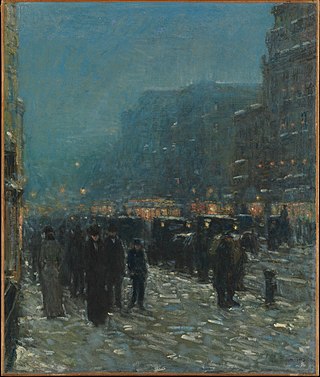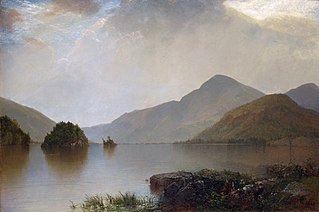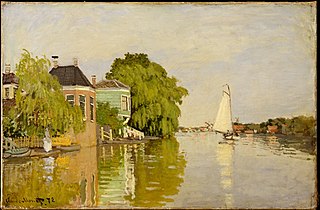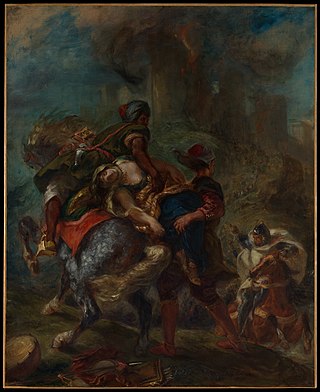
The Accommodations of Desire is a 1929 surrealist oil painting and mixed media collage on board by Spanish artist Salvador Dalí. It is now in the Metropolitan Museum of Art in New York City.

Broadway and 42nd Street is a 1902 painting by the American Impressionist painter Childe Hassam. It is part of the collection of the Metropolitan Museum of Art.

In a Courtyard, Tangier is a late 19th-century painting by French artist Philippe Pavy. Done in oil on wood, the work depicts a young woman resting in a Tangerian courtyard. The painting was one of a series of paintings Pavy produced after he traveled in North Africa in the 1880s. It is currently in the collection of the Metropolitan Museum of Art.

The Farm at Les Collettes, Cagnes is a late work period (1908–14) canvas painting by French artist Pierre-Auguste Renoir. It is in the collection of the Metropolitan Museum of Art.

Lake George is a mid 19th century painting by American artist John Frederick Kensett. Done in oil on canvas, the painting depicts Lake George in upstate New York. The painting is in the collection of the Metropolitan Museum of Art.

Boating is an 1874 painting by French artist Édouard Manet in the collection of the Metropolitan Museum of Art, New York.

Lady at the Tea Table is a late 19th-century painting by American artist Mary Cassatt. The work, done in oil on canvas, is in the collection of the Metropolitan Museum of Art.

Egyptian Woman with Earrings is a late 19th-century painting by American artist John Singer Sargent. Done in oil on canvas, the work portrays an Egyptian woman. The painting is in the collection of the Metropolitan Museum of Art in New York.

Ferry near Gorinchem is a mid 17th century painting by Dutch artist Salomon van Ruysdael. Done in oil on canvas, the work depicts a riverside embankment near Gorinchem in the Netherlands; in addition, the painting also depicts the prominent St Jan's Tower of the Grote Kerk, the town's church. Ruysdael's rendering of the land near Gorinchem was possibly impacted due to the artist's owning of a mill on the river. The work is in the collection of the Metropolitan Museum of Art.

Allegory of the Planets and Continents is a 1752 painting by Italian artist Giovanni Battista Tiepolo. Done in oil on canvas, the allegorical work uses human figures to represent members of the Greco-Roman pantheon, the planets, and four continents. The painting is an elaborate oil sketch made by Tiepolo in preparation for rendering a similar, larger version of his scene a massive fresco. Between December 1750 and November 1753, Tiepolo was commissioned to decorate the Prince-Bishopric of Würzburg Karl Philipp von Greifenclau zu Vollraths newly constructed palace on the ceiling of a staircase he created a massive fresco of over 600 m², it is considered the largest fresco in the world and is often considered his greatest achievement. The oil on canvas is an earlier version of his work. The intricate painting depicts figures circling around Tiepolo's rendering of Apollo, the sun god; this represents planets orbiting the Sun. The cornice of the painting symbolize the continents Europe, America, Africa, and Asia.

Autumn Ivy is an Edo period painting by Japanese artist Ogata Kenzan. Done in an assortment of ink, colors, and gold on paper, the work depicts ivy in Autumn. The painting recalls an episode from The Tales of Ise in which the tale's protagonist encounters a transient monk on the path to Mount Utsu.

Houses on the Achterzaan is an 1871 painting by French artist Claude Monet. Done in oil on canvas, the work depicts riverside garden houses on the west shore of the Achterzaan river in Zaandam, the Netherlands. He painted it from the dam in the Zaan, facing northwest. The painting is in the collection of the Metropolitan Museum of Art.

Cypresses is a late 19th-century painting by Dutch artist Vincent van Gogh painted around June 1889. Done in oil on canvas, the painting depicts a pair of cypress trees in the French countryside. The work is currently on display in the Metropolitan Museum of Art.

The Death of Harmonia is an 18th-century painting by French painter Jean-Baptiste Marie Pierre. Done in oil on canvas, the work depicts the death of Harmonia of Syracuse. The painting is in the collection of the Metropolitan Museum of Art.

Moses Striking the Rock is a late 16th century painting by Dutch artist Abraham Bloemaert. Done in oil on canvas, the work depicts a scene from the Old Testament in which the prophet Moses strikes the grounds to draw forth water for the Israelites. The painting is in the collection of the Metropolitan Museum of Art.

Morning, An Overcast Day, Rouen is a late 19th-century painting by Danish-French artist Camille Pissarro. Done in oil on canvas, the work depicts the industrial cityscape of Rouen, France. The centerpiece of the painting is Boieldieu Bridge, a steel arch bridge which Pissarro painted from his room in a nearby hotel. The painting is in the collection of the Metropolitan Museum of Art.

The Martyrdom of Saint Barbara is an early 16th century painting by German artist Lucas Cranach the Elder. It is in the collection of the Metropolitan Museum of Art, in New York.

The Abduction of Rebecca is a mid-19th century painting by French artist Eugène Delacroix. Done in oil on canvas, the work depicts the a scene from Sir Walter Scott's novel Ivanhoe in which the heroine Rebecca is abducted. Delacroix produced the painting during the height of the French Romanticist Movement, and presented the work at the Paris Salon of 1846. The 1846 version of Abduction is currently in the collection of the Metropolitan Museum of Art, which describes the work as "one of Delacroix’s greatest paintings". In 1858 Delacroix created an almost identical work for the Paris Salon of 1859; the second version of Abduction is in the collection of the Louvre.

Lobster Fishermen is an early 20th century painting by American artist Marsden Hartley. Done in oil on masonite, it depicts a group of lobster fishermen in Hartley's native state of Maine. Considered part of Hartley's 'Maine Series', it is in the collection of the Metropolitan Museum of Art.



















